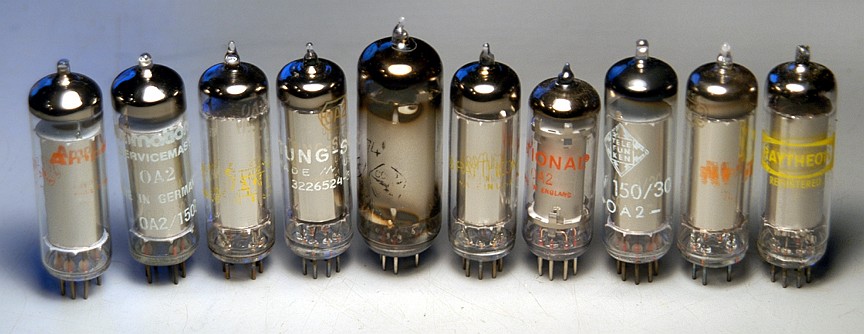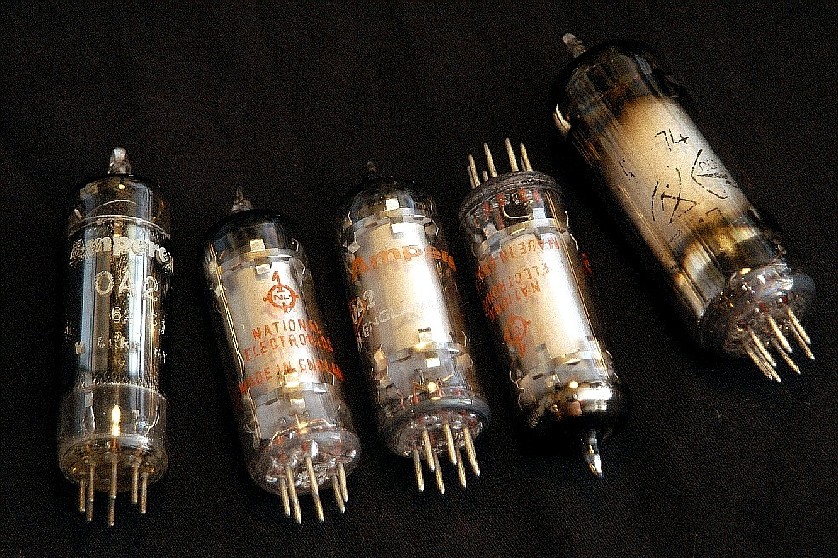I remember when I built Melquiades I detected that quietly of wire that feeds the grid of output stage with bias, quality of soldering or any other minute detail on this wire was very auditable. I also detected that the proximity of this wire to cassias was auditable. Understanding that anything that feeds grid is crucially important (try to play with shunt cap after the gas tube and you will kill the Milq sound) I ask myself: how about the “quality” of the gas tubes?
In Melquiades the gas tubes live after 9000uF capacitor (I do not use C12 as the PS sits very closed from output stage) and they are basically driven by DC. The gas tubes are wonderful “dumper” themselves and whatever own MF noise then generate blocked but the following stunt cap. Still, how do they “sound”, if then have any sound? The negative supply gas tube feeds the both grids and I presumed that should have some effect. The positive supply is kind of irrelevant and I did run the connected Milq without the positive supply, letting the amp to be grounded on the preamp output. I did not detect any sonic differences with or without the positive supply.
So, took some gas tubes that I had in my home now and decided to listening with all of them, trying to detect if it were any difference. As I usually do I kept a small log of my experiments and since, there WAS a sonic different in Milq with different gas tubes I decided to publish the results. A few things should be taken for consideration:
1) In Milq the gas tubes do not used like regulators but rather as “garbage absorbers” and I have no idea if in a different application the tubes might behave similarly
2) All tubes were new and “cold”. There were identically not pre-burned and before auditioning were running for 5min in hot amplifiers (the got warmed VERY fast when you drive 25mA thought them)
3) There is an army of the 150V 7-pins gas tubes: 0A2, SG1P, STV150/30, StR150/30, 150C1, G150m 150C2, 150C4, CV10664, CV1832, CV2903, CV8161, HD51, M8223, QS1207, GD150/4K, QS1210, SR56. I did not try the larger octal 150V tubes (I very much would like to and I will)
4) The differences that I detect were VERY minor, much less than a typical flipping of a signal tube from a “good brand” to “bad brand”.
5) Some related threads on the site:
http://www.goodsoundclub.com/TreeItem.aspx?postID=1818#1818
http://www.goodsoundclub.com/TreeItem.aspx?PostID=1339
So, I took my box of Cohiba and placed Verdi’s Rigoletto of 1956 into the game (Callas, Gobbi, Di Stefano by La Scala under Tullio Serafin. The result was following: (from left to right on the picture)


1) Holland Made Amperex with flat shield - All together correct sound, slightly more round then I would like to. The similar sound was by US’s General Electric (not on the picture). However, General Electric subjectively sounded louder but not more dynamic, juts louder.
2) German made National Servisemaster - in a way similar to above by has slightly more “yellow” tone.
3) USA’s Sylvania – very-very nice tube. Perfectly balanced and with no surprised. Dynamic vs. tone, sharpness vs. elegance… everything is perfect.
4) USA’ Tung-Sol –very interesting tube. It has some softness but some interesting attitude in it. It going down very elegantly but then suddenly jump on you but also in a very elegantly way. I do not get and I do not know if I like it but the effect is very interesting.
5) Russian SG1P – horrendous tube, absolutely the worst sound. It has tremendous slam but at the same time it completely washed out any tone. It almost sound like overly contrasty b/w picture of the a colorful landscape
6) USA’s Raytheon – a nice well balanced tube. For whatever reasons sound got “further” with this tube. Very strange affect indeed.
7) USA marked Nations – this tube is a contemporary bitch. The tube might be identified by the glossy sharp-ended pins. (on the second image 3 tubes in the middle) This is a contemporary production of Russia and the mark them as anything you can imagine (including the “original” boxes) I have seen them as Ampere, Raytheon, CVS, FEN, and God knows what. Pretty much everyone push this tube today as anything. Ironically the tube is not really bad. Sonically it is “almost” OK but it has some sharpness and aggressive that I do not like. This tube is heads and shoulders better then the Russian-made #5. Still, I feel that very-very slightly it loosing tonally to the Western tubes.
8) German made Telefunken – superbly tonally but overly soft. Also it eats some dynamic. The good parts about this tube (and completely irrelevant from my point of view) that it locks voltage closest to 150V then any other tubes – 149.98V
9) USA’s RCA – good tube but a bit too dull and not contrasty. At the same time it is not soft and has some “punch”, with a contradiction, isn’t it?
10) Another USA’s Raytheon Registered. Very similar to the #6. The effect of “further” does not manifest itself. Perhaps it is because it is a different batch?
11) Holland Made Amperex with screen shield – it is on the second image on the left – the best 0A2 that I have. Sonically it is identical to Sylvania but it has more dynamic. Tonally it is also superbly reach. A truly phenomenal performer!
Rgs,
Romy the caT
"I wish I could score everything for horns." - Richard Wagner. "Our writing equipment takes part in the forming of our thoughts." - Friedrich Nietzsche